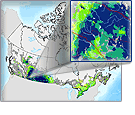Sol
Type of resources
Available actions
Topics
Keywords
Contact for the resource
Provided by
Years
Formats
Representation types
Update frequencies
status
Service types
-
The “Thematic Soil Maps of Manitoba” is a revised and condensed version of the Manitoba Detailed Soils Database produced by CANSIS. It contains data relating to the soils slope, drainage, agricultural capability, erosion potential, and surface texture.
-

Soil Landscapes of Canada (SLC) derived from V3.1 and V2.2 – Cartographic 1M will provide a general overview of soil landscapes in Canada at a scale of 1: 1 Million.
-
The “Thematic Soil Maps of Saskatchewan” is a revised and condensed version of the Saskatchewan Detailed Soils Database produced by CANSIS. It contains data relating to the soils slope, drainage, agricultural capability, erosion potential, and surface texture.
-

The “Soil Landscapes of Canada V.2.2/V.3.1 - Soil Order” displays the highest (most general) level of soil classification. Within the Canadian System of Soil Classification there are ten recognized soil orders (Soil Classification Working Group 1998). This system is hierarchical (from general to specific). Soil orders are further subdivided to great groups, subgroups, families, and series.
-

The “Soils of Canada, Derived” national scale thematic datasets display the distribution and areal extent of soil attributes such as drainage, texture of parent material, kind of material, and classification of soils in terms of provincial Detailed Soil Surveys (DDS) polygons, Soil Landscape Polygons (SLCs), Soil Order and Great Group. The relief and associated slopes of the Canadian landscape are depicted on the local surface form thematic dataset. The purpose of the “Soils of Canada, Derived” series is to facilitate the cartographic display and basic queries of the Soil Landscapes of Canada at a national scale. For more detailed or sophisticated analysis, users should investigate the full “Soil Landscapes of Canada” product.
-
Cet ensemble de données est aligné sur une grille et comprend un ensemble de données sur les attributs des sols respectant les normes et les spécifications du projet GlobalSoilMap à des incréments de profondeur spécifiés. Il s'étend sur la partie agricole du Canada. Les polygones de cartes du PPC ont été rastérisés et combinés à la grille de la mission SRTM (Shuttle Radar Topography Mission) avec une grille de 90 mètres pour créer l'ensemble de données matricielles quadrillé. Des moyennes pondérées des attributs des sols sont générées à partir d'information existante sur l'horizon pédologique pour respecter les incréments de profondeur fixes reconnus. Les moyennes pondérées des attributs des sols sont calculées en utilisant toutes les composantes des sols à partir de leur superficie dans chaque polygone du PPC. Les moyennes pondérées des attributs des polygones sont représentées spatialement par la grille. Pour plus d'information, consulter : http://ouvert.canada.ca/data/fr/dataset/cb29b370-3639-4645-9ef9-b1ef131837b7
-

The Prairie Soil Zones file shows the general distribution of major soil zones across the Prairie region of Canada. Soil zones (based on the Canadian System of Soil Classification) are named based on the dominant soil classification of the soils in each zone. Data extent is limited to the Agricultural Zone as defined in Soil Landscapes of Canada v 3.0 (Lefebvre et al. 2005).
-

The 2006 Derived Interpolated Census of Agriculture by Soil Landscapes of Canada takes a subset of attributes from the 2006 Agricultural Census and creates new derived attributes that show the proportionate contribution of a variable to the total.
-

The National Ecological Framework for Canada's "Soil Texture by Ecoprovince” dataset contains tables that provide soil texture information within the ecoprovince framework polygon. It provides soil texture codes and their English and French language descriptions as well as the percentage of the polygon that the component occupies. Soil texture indicates the relative proportions of the various soil separates (sand, silt, clay) as described by classes of texture. Soil separates are mineral particles, 2.0 mm in diameter and include: gravel 0.2 -7.5 cm and cobbles 7.5-25.0 cm. There are 12 texture group classes definitions and one class definition for Not Applicable (which indicates, for example, water, ice or urban areas).
-

The “Agro-Pedological Atlas of Quebec” is a dataset that shows the characteristics, the fertility, the quality of the water regime, the vulnerability to degradation and the potential of the agricultural soils and land in the Monteregian region of the province of Quebec.
 Arctic SDI catalogue
Arctic SDI catalogue